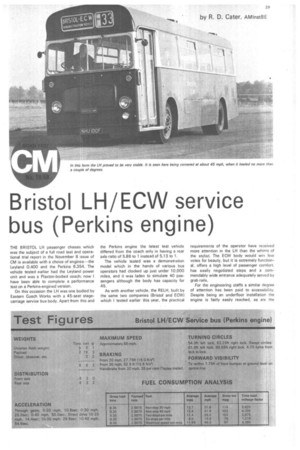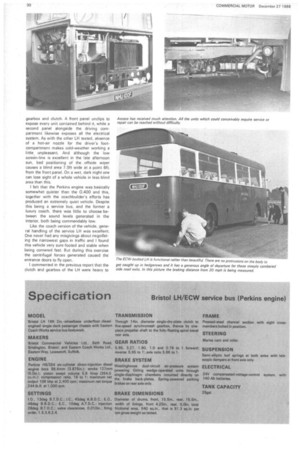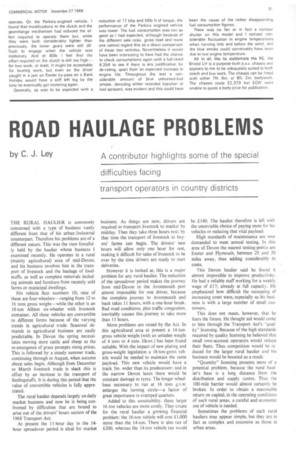Bristol LH/ECW service bus (Perkins engine)
Page 31

Page 32

Page 33

If you've noticed an error in this article please click here to report it so we can fix it.
THE BRISTOL LH passenger chassis which was the subject of a full road test and operational trial report in the November 8 issue of CM is available with a choice of engines—the Leyland 0.400 and the Perkins 6.354. The vehicle tested earlier had the Leyland power unit and was a Plaxton-bodied coach; now I have been able to complete a performance test on a Perkins-engined version.
On this occasion the LH was one bodied by Eastern Coach Works with a 45-seat stagecarriage service bus body. Apart from this and the Perkins engine the latest test vehicle differed from the coach only in having a rear axle ratio of 5.86 to 1 instead of 5.13 to 1.
The vehicle tested was a demonstration model which in the hands of various bus operators had clocked up just under 10,000 miles, and it was laden to simulate 40 passengers although the body has capacity for 45.
As with another vehicle, the RELH, built by the same two companies (Bristol and ECM which I tested earlier this year, the practical
requirements of the operator have received more attention in the LH than the whims of the stylist. The ECW body would win few votes for beauty, but it is extremely functional, offers a high level of passenger comfort, has easily negotiated steps and a commendably wide entrance adequately served by grab rails.
For the engineering staffs a similar degree of attention has been paid to accessibility. Despite being an underfloor installation the engine is fairly easily reached, as are the
gearbox and clutch. A front panel unclips to expose every unit contained behind it, while a second panel alongside the driving cornpartment likewise exposes all the electrical system. As with the other LH tested, absence of a hot-air nozzle for the driver's footcompartment makes cold-weather working a little unpleasant. And although the low screen-line is excellent in the late afternoon sun, bad positioning of the offside wiper causes a blind area 7.5ft wide at a point 6ft. from the front panel. On a wet, dark night one can lose sight of a whole vehicle in less blind area than this.
I felt that the Perkins engine was basically somewhat quieter than the 0.400 and this, together with the coachbuilder's efforts has produced an extremely quiet vehicle. Despite this being a service bus, and the former a luxury coach, there was little to choose between the sound levels generated in the interior, both being commendably low.
Like the coach version of the vehicle, general handling of the service LH was excellent. One never had any misgivings about negotiating the narrowest gaps in traffic and I found this vehicle very sure-footed and stable when being cornered fast. But during this exercise the centrifugal forces generated caused the entrance doors to fly open.
I commented in the previous report that the clutch and gearbox of the LH were heavy to operate. On the Perkins-engined vehicle, found that modifications to the clutch and the gearchange mechanism had reduced the effort required to operate them but, while they were both considerably lighter than previously, the lower gears were still difficult to engage when the vehicle was stationary. And at 80Ib I feel that the effort required on the clutch is still too high— for bus work, at least. It might be acceptable for touring work, but even so the driver caught in a jam on Exeter by-pass on a Bank Holiday would have a stiff left leg by the time he eventually got motoring again.
Generally, as was to be expected with a
reduction of 17 bhp and 56Ib ft of torque, the performance of the Perkins engined vehicle was lower. The fuel consumption was not so good as I had expected, although because of the different axle ratio, gross load and route one cannot regard this as a direct comparison of these two vehicles. Nevertheless it would have been interesting to have had the chance to check consumptions again with a full-rated 6.354 to see if there is any justification for de-rating, apart from-an expected increase in engine life. Throughout the test a considerable amount of blue unburned-fuel smoke, denoting either retarded injection or bad sprayers, was evident and this could have
been the cause of the rather disappointing fuel consumption figures.
There was no fan or in fact a radiator shutter on this model and I noticed considerable fluctuation in engine temperatures when running into and before the wind, and the blue smoke could conceivably have been due to low engine temperature.
All in all, like its stablemate the RE, the Bristol LH is a purpose-built p.s.v. chassis and appears to me to be adequately suited to both coach and bus work. The chassis can be fitted with either 71t. Sin. or Sft. 2in. bodywork. The chassis costs £2,379 but ECW were unable to quote a body price for publication.












































































